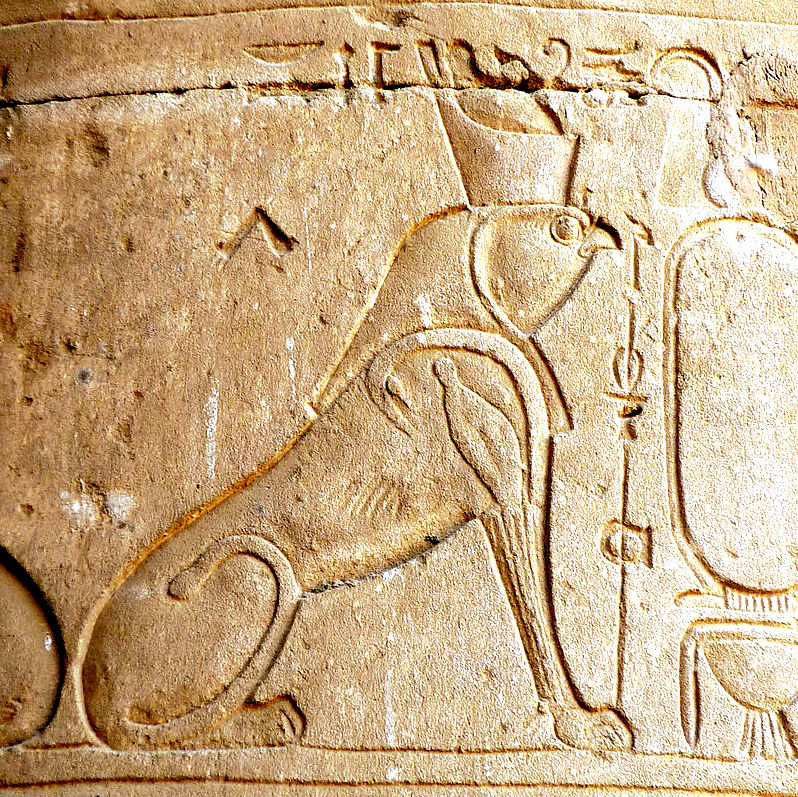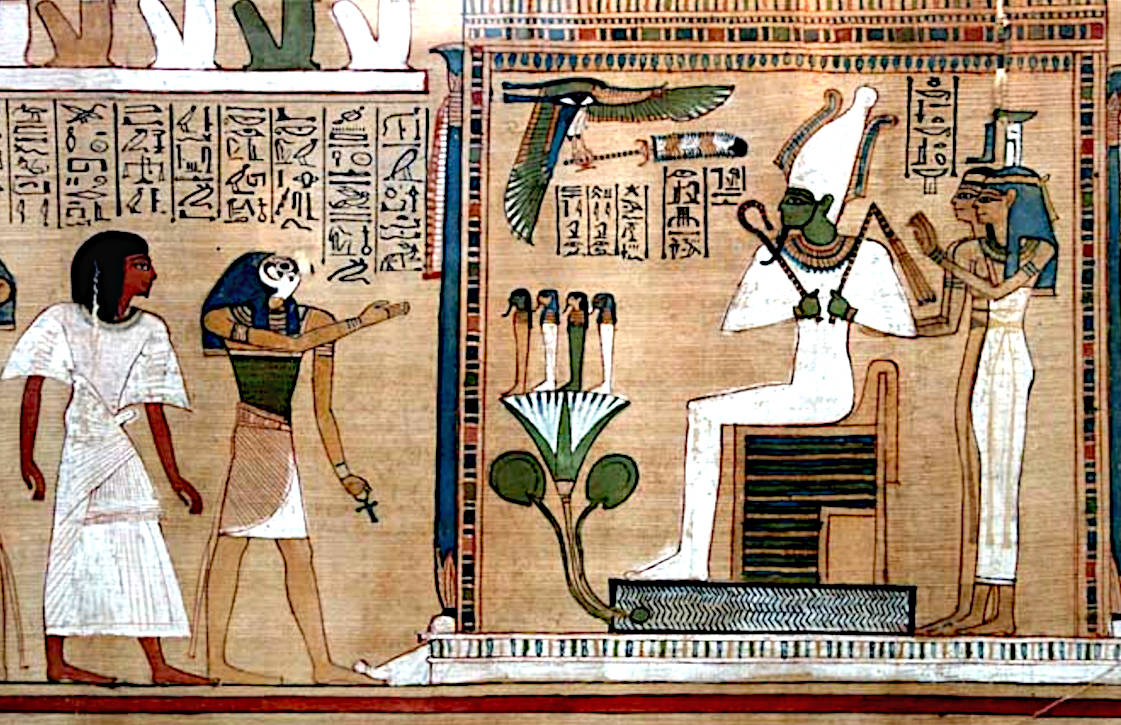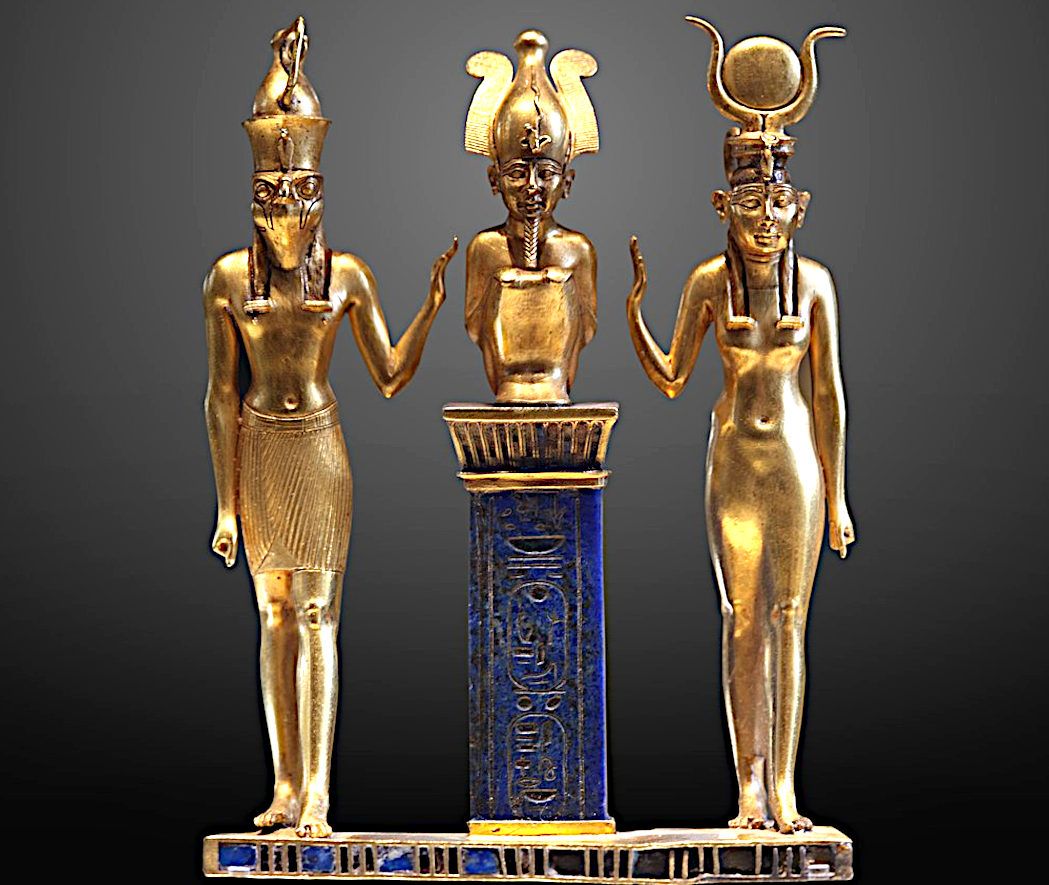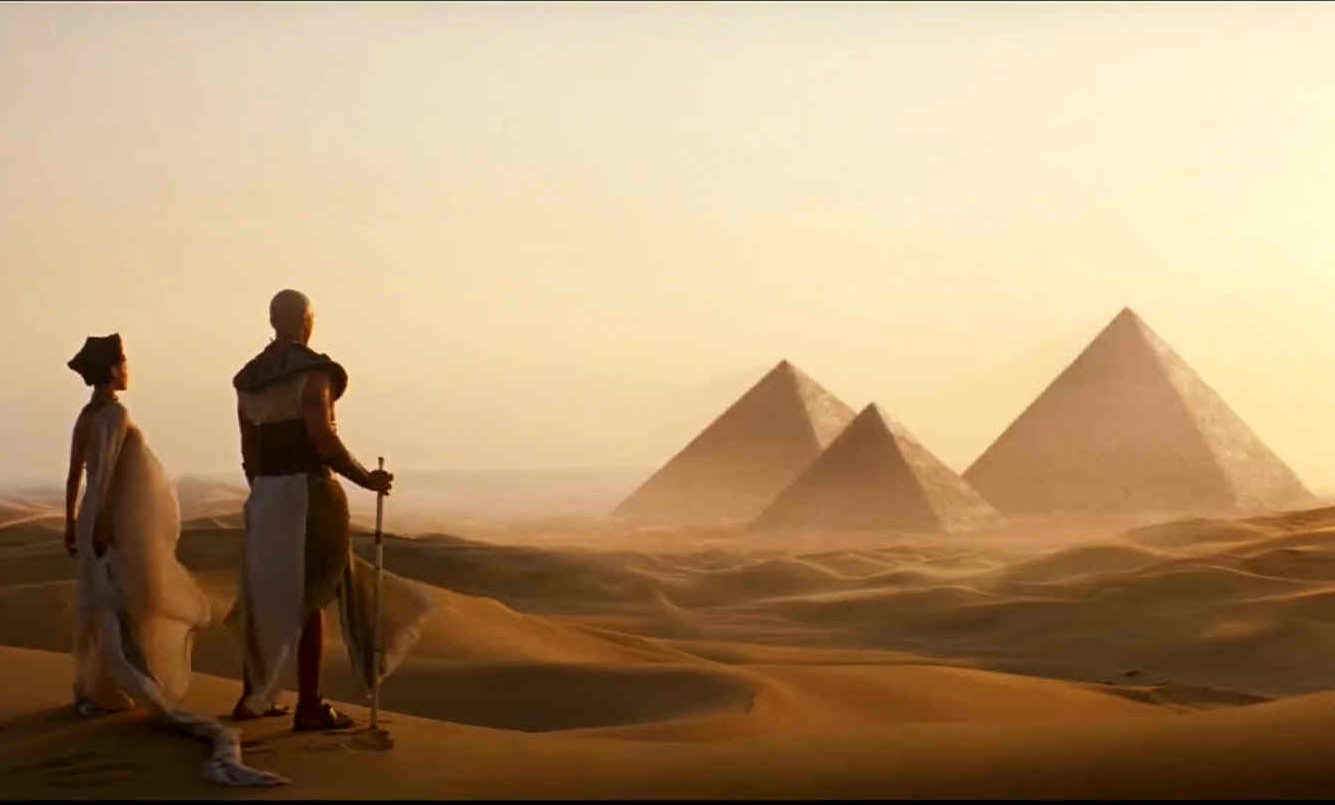
Horus
Horus or Heru, Hor, Har in Ancient Egyptian, is one of the most significant ancient Egyptian deities who served many functions, most notably god of kingship and the sky. He was worshipped from at least the late prehistoric Egypt until the Ptolemaic Kingdom and Roman Egypt. Different forms of Horus are recorded in history, and these are treated as distinct gods by Egyptologists. These various forms may possibly be different manifestations of the same multi-layered deity in which certain attributes or syncretic relationships are emphasized, not necessarily in opposition but complementary to one another, consistent with how the Ancient Egyptians viewed the multiple facets of reality. He was most often depicted as a falcon, most likely a lanner falcon or peregrine falcon, or as a man with a falcon head.
Horus the falcon god was Egypt’s first national god worshiped by all of Egypt. One of the most important gods of ancient Egypt, the worship of Horus spanned over 5,000 years. With mention in records from the late pre-dynastic period through Roman times, Horus became the catch-all name for many different gods associated with falcons. Egyptian mythology features many different versions of his name, family and importance.
Horus is always seen as the ruler of the gods represented by a falcon. He was also known as the patron saint of the existing pharaoh, who was often referred to as the 'Living Horus'.

Egyptians viewed Horus as the protector of the Pharaoh. As a god known in all of Egypt, he was an important unifying tool used to tie the people together under their leader. Great efforts were taken by rulers to show themselves as Horus in human form. When associated with a pharaoh, Horus was represented as a hawk resting on the shoulder of the pharaoh with his wings spread around the pharaoh’s head. Pharaohs would take on a Horus name to tie themselves to the god in both their reign and their afterlife.
In believing that Horus ruled the Earth under the authority of the gods, it was important for Pharaoh to become Horus in a living form. When the Pharaoh died, this association would unite the ruler with
Osiris in the underworld. Horus would then move into the form of the next pharaoh.
The earliest recorded form of Horus is the tutelary deity of Nekhen in Upper Egypt, who is the first known national god, specifically related to the ruling pharaoh who in time came to be regarded as a manifestation of Horus in life and Osiris in death. The most commonly encountered family relationship describes Horus as the son of Isis and Osiris, and he plays a key role in the Osiris myth as Osiris's heir and the rival to Set, the murderer and brother of Osiris. In another tradition Hathor is regarded as his mother and sometimes as his wife.
Claudius Aelianus wrote that Egyptians called the god Apollo "Horus" in their own language.

MYTHOLOGICAL ORIGINS
Horus was born to the goddess Isis after she retrieved all the dismembered body parts of her murdered husband Osiris, except his penis, which was thrown into the
Nile and eaten by a catfish, or sometimes depicted as instead by a crab, and according to Plutarch's account used her magic powers to resurrect Osiris and fashion a phallus to conceive her son (older Egyptian accounts have the penis of Osiris surviving).
After becoming pregnant with Horus, Isis fled to the Nile Delta marshlands to hide from her brother Set, who jealously killed Osiris and who she knew would want to kill their son. There Isis bore a divine son, Horus.
SKY GOD
Since Horus was said to be the sky, he was considered to also contain the Sun and
Moon. Egyptians believed that the Sun was his right eye and the Moon his left, and that they traversed the sky when he, a falcon, flew across it. Later, the reason that the Moon was not as bright as the Sun was explained by a tale, known as The Contendings of Horus and Seth. In this tale, it was said that Set, the patron of Upper Egypt, and Horus, the patron of Lower Egypt, had battled for Egypt brutally, with neither side victorious, until eventually, the gods sided with Horus.
As Horus was the ultimate victor he became known as ḥr.w wr "Horus the Great", but more usually translated "Horus the Elder". In the struggle, Set had lost a testicle, and Horus' eye was gouged out.
Horus was occasionally shown in art as a naked boy with a finger in his mouth sitting on a lotus with his mother. In the form of a youth, Horus was referred to as nfr ḥr.w "Good Horus", transliterated Neferhor, Nephoros or Nopheros (reconstructed as naːfiru ħaːruw).
The Eye of Horus is an ancient Egyptian symbol of protection and royal power from deities, in this case from Horus or Ra. The symbol is seen on images of Horus' mother, Isis, and on other deities associated with her. In the Egyptian language, the word for this symbol was "wedjat" (wɟt). It was the eye of one of the earliest of Egyptian deities, Wadjet, who later became associated with Bastet, Mut, and Hathor as well. Wadjet was a solar deity and this symbol began as her all-seeing eye. In early artwork, Hathor is also depicted with this eye. Funerary amulets were often made in the shape of the Eye of Horus. The Wedjat or Eye of Horus is "the central element" of seven "gold, faience, carnelian and lapis lazuli" bracelets found on the mummy of Shoshenq II. The Wedjat "was intended to protect the king [here] in the afterlife" and to ward off evil. Egyptian and Near Eastern sailors would frequently paint the symbol on the bow of their vessel to ensure safe sea travel.

CONFLICT BETWEEN HORUS AND SET
The Eye of Horus is an ancient Egyptian symbol of protection and royal power from deities, in this case from Horus or Ra. The symbol is seen on images of Horus' mother, Isis, and on other deities associated with her. In the Egyptian language, the word for this symbol was "wedjat" (wɟt). It was the eye of one of the earliest of Egyptian deities, Wadjet, who later became associated with Bastet, Mut, and Hathor as well. Wadjet was a solar deity and this symbol began as her all-seeing eye. In early artwork, Hathor is also depicted with this eye. Funerary amulets were often made in the shape of the Eye of Horus. The Wedjat or Eye of Horus is "the central element" of seven "gold, faience, carnelian and lapis lazuli" bracelets found on the mummy of Shoshenq II. The Wedjat "was intended to protect the king [here] in the afterlife" and to ward off evil. Egyptian and Near Eastern sailors would frequently paint the symbol on the bow of their vessel to ensure safe sea travel.
However, Set still refused to relent, and the other gods were getting tired from over eighty years of fighting and challenges. Horus and Set challenged each other to a boat race, where they each raced in a boat made of stone. Horus and Set agreed, and the race started. But Horus had an edge: his boat was made of wood painted to resemble stone, rather than true stone. Set's boat, being made of heavy stone, sank, but Horus' did not. Horus then won the race, and Set stepped down and officially gave Horus the throne of Egypt. After the New Kingdom, Set was still considered lord of the desert and its oases.
In many versions of the story, Horus and Set divide the realm between them. This division can be equated with any of several fundamental dualities that the Egyptians saw in their world. Horus may receive the fertile lands around the Nile, the core of Egyptian civilization, in which case Set takes the barren desert or the foreign lands that are associated with it; Horus may rule the earth while Set dwells in the sky; and each god may take one of the two traditional halves of the country, Upper and Lower Egypt, in which case either god may be connected with either region. Yet in the Memphite Theology, Geb, as judge, first apportions the realm between the claimants and then reverses himself, awarding sole control to Horus. In this peaceable union, Horus and Set are reconciled, and the dualities that they represent have been resolved into a united whole. Through this resolution, order is restored after the tumultuous conflict.

Egyptologists have often tried to connect the conflict between the two gods with political events early in Egypt's history or prehistory. The cases in which the combatants divide the kingdom, and the frequent association of the paired Horus and Set with the union of Upper and Lower Egypt, suggest that the two deities represent some kind of division within the country. Egyptian tradition and archaeological evidence indicate that Egypt was united at the beginning of its history when an Upper Egyptian kingdom, in the south, conquered Lower Egypt in the north.
The Upper Egyptian rulers called themselves "followers of Horus", and Horus became the tutelary deity of the unified polity and its kings. Yet Horus and Set cannot be easily equated with the two halves of the country. Both deities had several cult centers in each region, and Horus is often associated with Lower Egypt and Set with Upper Egypt. Other events may have also affected the myth. Before even Upper Egypt had a single ruler, two of its major cities were Nekhen, in the far south, and Nagada, many miles to the north. The rulers of Nekhen, where Horus was the patron deity, are generally believed to have unified Upper Egypt, including Nagada, under their sway.
Set was associated with Nagada, so it is possible that the divine conflict dimly reflects an enmity between the cities in the distant past. Much later, at the end of the Second Dynasty (c. 2890–2686 BCE), Pharaoh Seth-Peribsen used the Set animal to writing his serekh name in place of the falcon hieroglyph representing Horus. His successor Khasekhemwy used both Horus and Set in the writing of his serekh. This evidence has prompted conjecture that the Second Dynasty saw a clash between the followers of the Horus king and the worshippers of Set led by Seth-Peribsen. Khasekhemwy's use of the two animal symbols would then represent the reconciliation of the two factions, as does the resolution of the myth.
GOLDEN HORUS OSIRIS
Horus gradually took on the nature as both the son of Osiris and Osiris himself. He was referred to as Golden Horus Osiris. In the temple of Denderah he is given the full royal titulary of both that of Horus and Osiris. He was sometimes believed to be both the father of himself as well as his own son, and some later accounts have Osiris being brought back to life by Isis.

...
|






